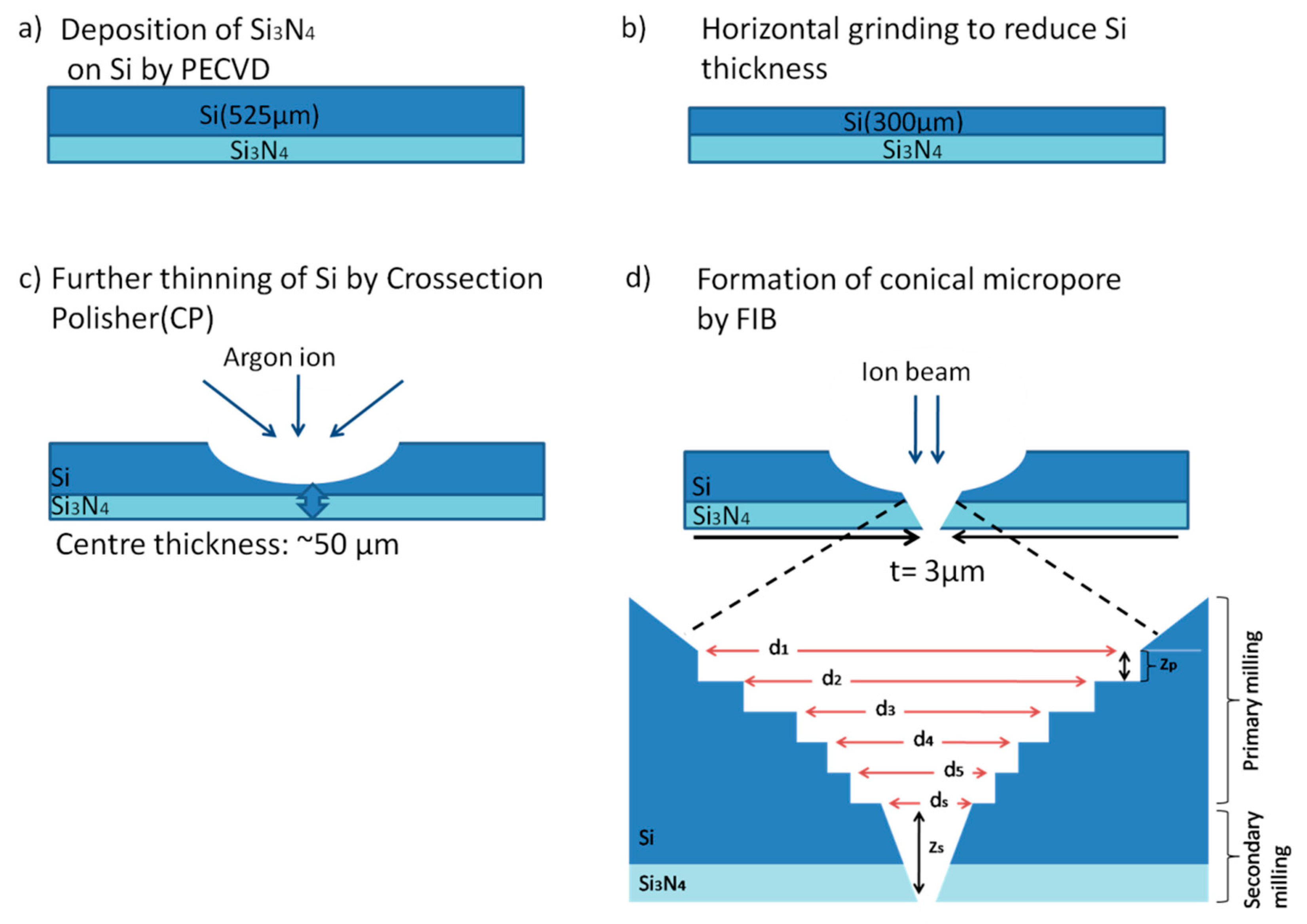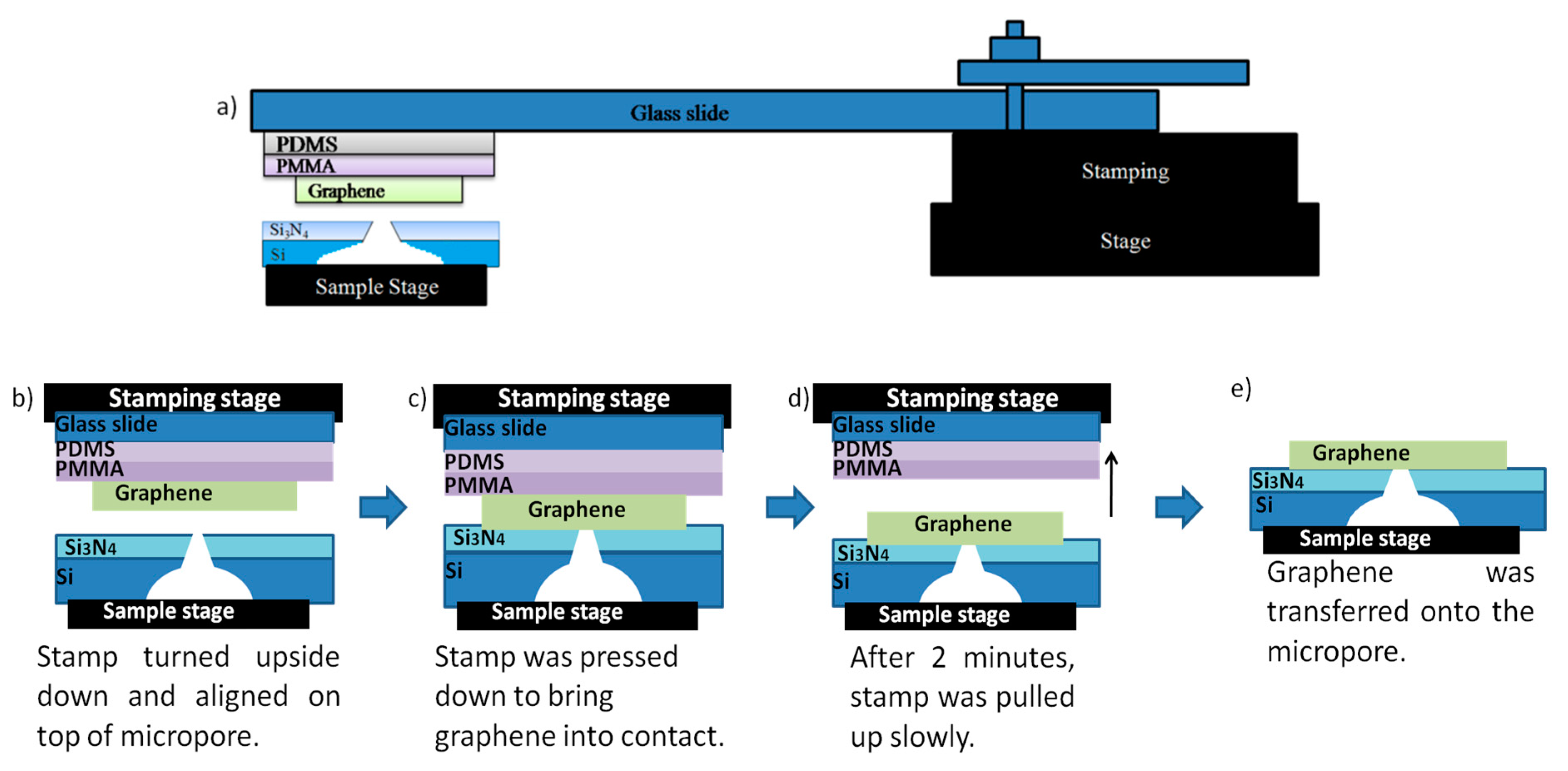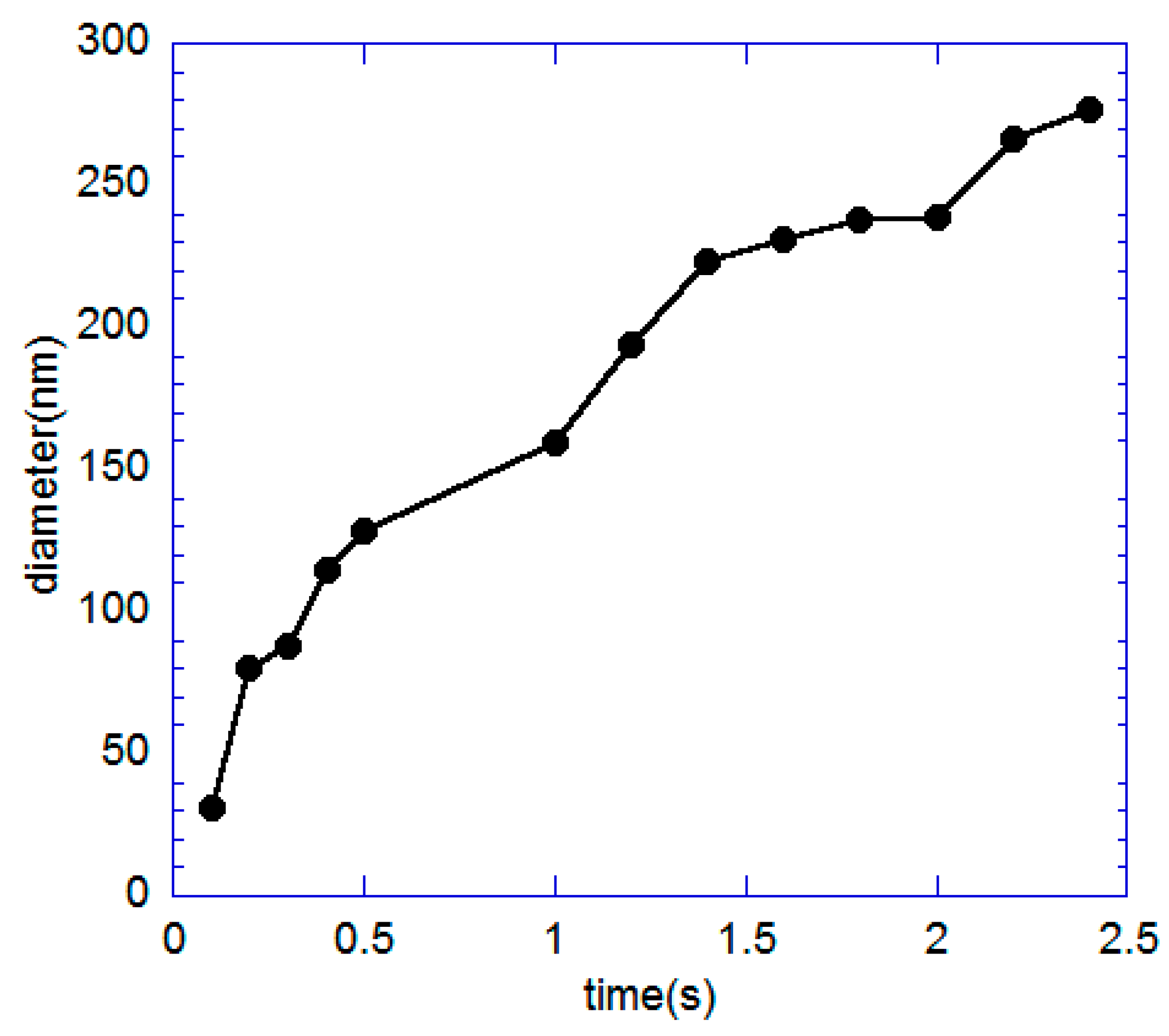Fabrication of Si Micropore and Graphene Nanohole Structures by Focused Ion Beam
Abstract
:1. Introduction
2. Materials and Methods
3. Results
4. Conclusions
Author Contributions
Funding
Acknowledgments
Conflicts of Interest
References
- Kavita, V. DNA biosensors—A review. Bioeng. Biomed. Sci. 2017, 7, 1–5. [Google Scholar]
- Agah, S.; Zheng, M.; Pasquali, M.; Kolomeisky, A.B. DNA sequencing by nanopores: Advances and challenges. J. Phys. D Appl. Phys. 2016, 49, 1–23. [Google Scholar] [CrossRef] [Green Version]
- Shendure, J.; Lieberman, A.E. The expanding scope of DNA sequencing. Nat. Biotechnol. 2003, 30, 1084–1094. [Google Scholar] [CrossRef] [PubMed] [Green Version]
- Mardis, E.R. Next generation DNA sequencing methods. Annu. Rev. Genom. Hum. Genet. 2008, 9, 387–402. [Google Scholar] [CrossRef] [PubMed] [Green Version]
- Chaisson, M.; Wilson, R.; Eichler, E. Genetic variation and the de novo assembly of human genomes. Nat. Rev. Gen. 2015, 16, 627–640. [Google Scholar] [CrossRef]
- Haque, F.; Li, J.; Wu, H.C.; Liang, X.J.; Guo, P. Solid-state and biological nanopore for real-time sensing of single chemical and sequencing of DNA. Nano Today 2013, 8, 56–74. [Google Scholar] [CrossRef] [Green Version]
- Venkatesan, B.M.; Bashir, R. Nanopore sensors for nucleic acid analysis. Nat. Nanotechnol. 2011, 6, 615–624. [Google Scholar]
- Branton, D.; Deamer, D.W.; Marziali, A.; Bayley, H.; Benners, S.A.; Butler, T.; Ventra, M.D.; Garaj, S.; Hibbs, A.; Huang, X.; et al. The potential and challenges of nanopore sequencing. Nat. Biotechnol. 2008, 26, 1146–1153. [Google Scholar] [CrossRef]
- Lee, K.; Park, K.B.; Kim, H.J.; Yu, J.S.; Chae, H.; Kim, H.M.; Kim, K.B. Recent progress in solid-state nanopores. Adv. Mater. 2018, 30, 1–28. [Google Scholar] [CrossRef]
- Kasianowicz, J.J.; Brandin, E.; Branton, D.; Deamer, D.W. Characterization of individual polynucleotide molecules using a membrane channel. Proc. Natl. Acad. Sci. USA 1996, 93, 13770. [Google Scholar]
- Liu, Z.; Wang, Y.; Deng, T.; Chen, Q. Solid-state nanopore-based DNA sequencing technology. J. Nano Mater. 2016, 2016, 1–14. [Google Scholar] [CrossRef]
- Fologea, D.; Gershow, M.; Ledden, B.; McNabb, D.S.; Golovchenko, J.A.; Li, J. Detecting single stranded DNA with a solid state nanopore. Nano Lett. 2005, 5, 1905–1909. [Google Scholar] [CrossRef] [PubMed] [Green Version]
- Li, J.; Stein, D.; McMullan, C.; Branton, D.; Aziz, M.J.; Golovchenko, J.A. Ion-beam sculpting at nanometre length scales. Nature 2001, 412, 166–169. [Google Scholar] [CrossRef] [PubMed] [Green Version]
- Storm, A.J.; Chen, J.H.; Ling, X.S.; Zandbergen, H.W.; Dekker, C. Fabrication of solid-state nanopores with single-nanometre precision. Nat. Mat. 2003, 2, 537–540. [Google Scholar] [CrossRef]
- Ying, L.Y.; Cao, C.; Long, Y.T. Single molecule analysis by biological nanopore sensors. Analyst 2014, 139, 3826–3835. [Google Scholar] [CrossRef]
- Soni, G.V.; Meller, A. Progress toward ultrafast DNA sequencing using solid-state nanopores. Clin. Chem. 2007, 53, 1996–2001. [Google Scholar] [CrossRef] [Green Version]
- Lu, C.; Yu, P. Biological and solid-state nanopores for DNA sequencing. Biochem. Pharmacol. 2012, 1, 1–2. [Google Scholar] [CrossRef] [Green Version]
- Wells, D.B.; Belkin, M.; Comer, J.; Aksimentiev, A. Assessing Graphene nanopores for sequencing DNA. Nano Lett. 2012, 12, 4117–4123. [Google Scholar] [CrossRef] [Green Version]
- Novoselov, K.S.; Geim, A.K.; Morozov, S.V.; Jiang, D.; Zhang, Y.; Dubonos, S.V.; Grigorieva, I.V.; Firsov, A.A. Electric field effect in atomically thin carbon films. Science 2004, 306, 666–669. [Google Scholar] [CrossRef] [Green Version]
- Geim, A.K.; Novoselov, K.S. The rise of graphene. Nat. Mater. 2007, 6, 183–191. [Google Scholar] [CrossRef]
- Jiang, L.; Fan, Z. Design of advanced porous graphene materials: From graphene nanomesh to 3D architectures. Nanoscale 2014, 6, 1922–1945. [Google Scholar] [CrossRef] [PubMed]
- Merchant, C.A.; Healy, K.; Wanunu, M.; Ray, V.; Peterman, N.; Bartel, J.; Fischbein, M.D.; Venta, K.; Luo, Z.; Johnson, A.T.C.; et al. DNA translocation through graphene nanopores. Nano Lett. 2010, 10, 2915–2921. [Google Scholar] [CrossRef] [PubMed]
- Goyal, G.; Lee, Y.B.; Darvish, A.; Ahn, C.W.; Kim, M.J. Hydrophilic and size- controlled graphene nanopores for protein detection. Nano Technol. 2016, 27, 1–13. [Google Scholar] [CrossRef] [PubMed] [Green Version]
- Tu, B.; Bai, S.; Lu, B.; Fang, Q. Conic shapes have higher sensitivity than cylindrical ones in nanopore DNA sequencing. Sci. Rep. 2018, 8, 1–11. [Google Scholar] [CrossRef] [PubMed] [Green Version]
- Li, N.; Yu, S.; Harrell, C.C.; Martin, C.R. Conical nanopore membranes. preparation and transport properties. Anal. Chem. 2004, 76, 2025–2030. [Google Scholar] [CrossRef] [PubMed]
- Scneider, G.F.; Kowalczyk, S.W.; Calado, V.E.; Pandraud, G.; Zandbergen, H.W.; Vandersypen, L.M.K.; Dekker, C. DNA translocation through graphene nanopores. Nano. Lett. 2010, 10, 3163–3167. [Google Scholar] [CrossRef] [PubMed] [Green Version]
- Wanunu, M.; Dadosh, T.; Ray, V.; Jin, J.; McReynolds, L.; Drndic, M. Rapid electronic detection of probe-specific micrornas using thin nanopore sensors. Nat. Nanotechnol. 2010, 5, 807–814. [Google Scholar] [CrossRef]
- Fu, Y.Q.; Bryan, N.K.A.; Shing, O.N.; Hung, N.P. Influence of redepostion effect for focused ion beam 3D micromachining in Silicon. Int. J. Adv. Manuf. Technol. 2000, 16, 877–880. [Google Scholar] [CrossRef]
- Ariffin, N.M.Z.; Yahaya, H.; Shinano, S.; Tanaka, S.; Hashim, A.M. Fabrication of conical micropore structure on silicon nitride/ silicon using focused ion beam milling for biosensor application. Microelectron. Eng. 2014, 133, 1–5. [Google Scholar] [CrossRef]
- Suk, J.W.; Kitt, A.; Magnuson, C.W.; Hao, Y.; Ahmed, S.; An, J.; Swan, A.K.; Goldberg, B.B.; Ruoff, R.S. Transfer of CVD- grown monolayer graphene onto arbitrary substrate. ACS Nano 2011, 5, 6916–6924. [Google Scholar] [CrossRef]
- Reina, A.; Jia, X.; Ho, J.; Nezich, D.; Son, H.; Bulovic, V.; Dresselhaus, M.S.; Kong, J. Large area few layer graphene films on arbitrary substrate by chemical vapor deposition. Nano Lett. 2009, 9, 30–35. [Google Scholar] [CrossRef] [PubMed]
- Kim, S.; Dyck, O.; Ievlev, A.V.; Vlassiouk, I.V.; Kalinin, S.V.; Belianinov, A.; Jesse, S.; Ovchinnikova, O.S. Graphene milling dynamics during helium ion beam irradiation. Carbon 2018, 138, 277–282. [Google Scholar] [CrossRef]








© 2020 by the authors. Licensee MDPI, Basel, Switzerland. This article is an open access article distributed under the terms and conditions of the Creative Commons Attribution (CC BY) license (http://creativecommons.org/licenses/by/4.0/).
Share and Cite
Md Ibrahim, N.N.N.; Hashim, A.M. Fabrication of Si Micropore and Graphene Nanohole Structures by Focused Ion Beam. Sensors 2020, 20, 1572. https://doi.org/10.3390/s20061572
Md Ibrahim NNN, Hashim AM. Fabrication of Si Micropore and Graphene Nanohole Structures by Focused Ion Beam. Sensors. 2020; 20(6):1572. https://doi.org/10.3390/s20061572
Chicago/Turabian StyleMd Ibrahim, Nik Noor Nabilah, and Abdul Manaf Hashim. 2020. "Fabrication of Si Micropore and Graphene Nanohole Structures by Focused Ion Beam" Sensors 20, no. 6: 1572. https://doi.org/10.3390/s20061572



